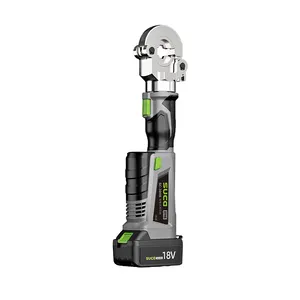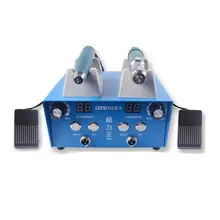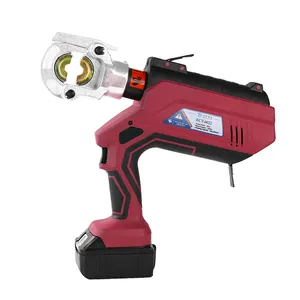The Purpose and Function of Crimping Tools for Batteries
Crimping tools for batteries are specialized devices crafted to affix terminals to battery cells, enabling the establishment of dependable connections within battery packs and systems. These tools are indispensable for battery manufacturers, technicians, and DIY enthusiasts involved in assembling or maintaining battery-operated devices. Through the crimping process, the terminal is molded around the battery's wire, forming a robust and enduring bond that guarantees the smooth flow of electrical current.
The crux of crimping lies in its straightforward yet essential role in electrical connections: the pressure exerted by the tool's jaws compels the terminal material to tightly conform to the wire, resulting in a secure electrical path. Typically carried out with manual hand tools that necessitate physical exertion to clamp the terminal onto the wire, there are also automated crimping machines available for high-volume operations, ensuring consistent and precise crimps with minimal human intervention.
Available in various sizes and styles tailored to specific terminal types and wire gauges, crimping tools for batteries span from basic manual hand tools to advanced pneumatic or hydraulic machines for industrial purposes. The quality of the crimp holds paramount importance as it directly impacts the safety and dependability of the electrical connection. Consequently, these tools are engineered to apply the precise amount of force required for a secure connection without causing damage to the components.
Varieties of Crimping Tools for Batteries
Battery crimping tools manifest in diverse forms to meet the varied demands of industries and battery categories, including:
-
Handheld Crimping Tools: Portable and user-friendly, ideal for professionals on-the-go or hobbyists, primarily used for smaller battery terminals and situations necessitating mobility.
-
Bench-Top Crimping Tools: Stationary machines designed for higher volume usage with precise control, offering consistent outcomes, commonly employed in manufacturing facilities or repair workshops where efficiency is critical.
-
Battery Terminal Crimping Tools: Tailored for securely attaching battery terminals, equipped with features like rotating dies for a 360-degree crimp or specific designs accommodating various terminal shapes.
-
Heavy-Duty Crimping Tools: Engineered for handling larger cables and thicker materials, these tools deliver the high force required for crimping substantial battery cables, often utilized in automotive and industrial settings.
-
Electric Crimping Tools: Featuring battery-powered operation for convenience, eliminating the need for manual force, suitable for scenarios demanding rapid crimping of battery terminals.
Each type serves distinct purposes based on the specific requirements of the battery type in question and the operational environment where the crimping tool will be utilized.
Choosing the Right Crimping Tool for Battery Applications
Selection of an appropriate crimping tool is pivotal in ensuring a dependable electrical connection. Businesses contemplating crimping tools for batteries should factor in several considerations:
-
Compatibility: Verify that the tool aligns with the size and type of battery terminal intended for use. A tool tailored for large automotive battery terminals may not suit smaller electronics batteries.
-
Material: Opt for durable materials like carbon steel or stainless steel capable of withstanding repetitive use, ensuring prolonged service life.
-
Handle Material: Evaluate the comfort and grip of the handle material, especially for frequent usage. Handles with soft grip plastic may enhance comfort during extended crimping sessions.
-
Application: Consider the specific application of the crimping tool, whether for construction, automotive, power generation, or commercial purposes, ensuring the tool can accommodate the requisite workload and type of tasks.
-
After-Sales Service: Reliable after-sales support is crucial for businesses procuring tools. Seek suppliers offering support services such as OEM or ODM options, particularly if custom tooling is needed for unique applications.
Deliberating on these factors equips businesses to select crimping tools tailored to their operational requirements while ensuring quality connections in their daily undertakings.
Exploring Crimping Tools for Batteries on Alibaba.com
Alibaba.com boasts a wide array of crimping tools suitable for diverse industries and applications. Serving as a global marketplace connecting buyers with suppliers worldwide since 1999, Alibaba.com stands as a dependable platform where businesses can discover tools tailored to their specific needs. Whether in search of robust wire connectors for large-scale construction ventures or precision crimping solutions for delicate electronic components, Alibaba.com presents a diverse selection from verified suppliers.
The platform streamlines the purchasing process by enabling direct communication between businesses and suppliers to negotiate terms aligning with their requirements. Additionally, Alibaba.com's Trade Assurance service ensures payment protection for buyers until satisfactory order fulfillment, underscoring the platform's commitment to fostering trust within its trading community.
Opting for Alibaba.com as the source for wholesale crimping tools offers the advantage of a user-friendly interface accommodating mobile transactions and multilingual communication, enhancing operational efficiency for businesses of all sizes and locations. With access to an array of products across different categories and support services like OEM and ODM customization, Alibaba.com emerges as a comprehensive marketplace for B2B transactions geared towards empowering businesses with the requisite tools for driving growth.
Frequently Asked Questions about Crimping Tools for Batteries
What is the function of a crimping tool?
A crimping tool serves to connect various materials, such as wires, cables, and connectors, utilizing a crimping mechanism to establish a secure and durable bond.
How can I determine the appropriate size of a crimping tool for my business needs?
To ascertain the correct size of a crimping tool, consider the range of wire gauges and connector types you intend to work with. The tool's specifications will indicate compatibility with specific connectors.
Can a single crimping tool be used for different connector types?
While some crimping tools are versatile and can accommodate various connector types, others are designed for specific connector models. Always verify the tool's compatibility with your connectors to ensure proper crimping.
What safety precautions should be observed when using a crimping tool?
When employing a crimping tool, it is imperative to utilize a tool in good working condition and adhere to the manufacturer's instructions. Additionally, always wear suitable personal protective gear and follow standard safety protocols.
What maintenance practices are necessary for crimping tools?
Regular maintenance is essential to preserve the functionality of crimping tools, including post-use cleaning, inspection for wear on crimping jaws, and regular lubrication of moving parts.
How does a battery-powered crimping tool differ from a hydraulic one?
Battery-powered crimping tools offer portability and ease of use without the need for a hydraulic pump or air compressor, making them suitable for fieldwork or locations lacking easy access to power sources.
What types of after-sales support are available for crimping tools?
After-sales support may vary by supplier but could include video technical assistance, online support, or engineers available for machinery servicing overseas. It is advisable to confirm the support options provided before making a purchase.
Is customization of crimping tools possible?
Yes, certain suppliers offer customization services such as OEM, ODM, and OBM, enabling businesses to tailor crimping tools to specific requirements or even brand them with their logo.
Which materials are commonly utilized in crafting crimping tools?
Commonly used materials in crimping tools include copper, carbon steel, carbon steel with plastic handles, and occasionally aluminum alloy for lighter tools, chosen for their electrical conductivity, strength, and durability.
Can a ratcheting crimper be used for all connector types?
Ratcheting crimpers are versatile tools suitable for various connector types. Nevertheless, it is essential to select a crimping tool compatible with the specific design and size requirements of the connector.
How can consistent crimping quality be ensured when utilizing different crimping tools?
To maintain consistent quality across different crimping tools, adhere to the manufacturer's instructions for each tool model and consistently apply appropriate techniques.










































 浙公网安备 33010002000092号
浙公网安备 33010002000092号 浙B2-20120091-4
浙B2-20120091-4